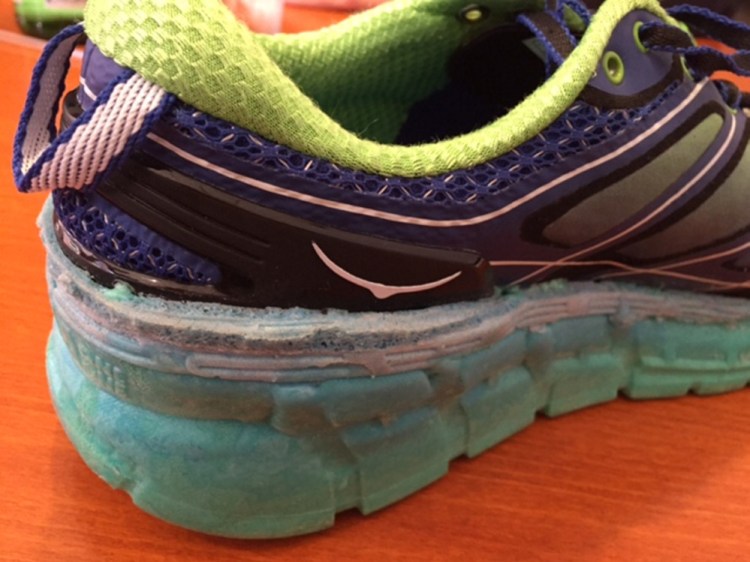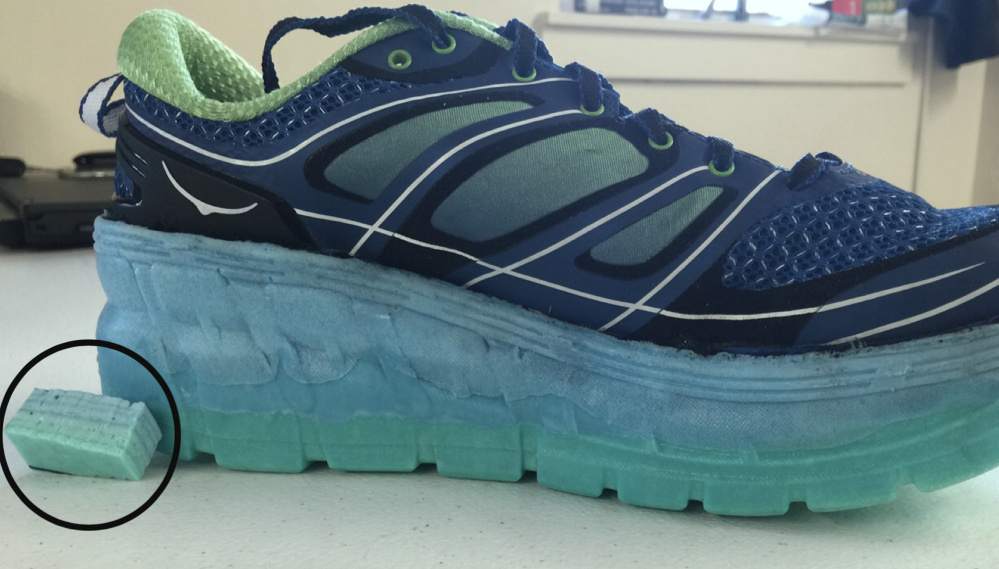A Bangor startup is trying to revolutionize the footwear industry, bringing 21st-century technology to one of the state’s oldest industries.
On Monday, Cobbler Technologies closed on a round of equity financing from Boston investors to help the fledgling company bring its 3D printer technology to the $250 billion global shoe industry. The printer, which carries the trademark Atomized Particle Deposition, or APD, is unusual in that it can apply layers of different materials – think rubber and foam – while building the bottom of a running shoe without having to stop the printer to change the materials being used.
“Lots of shoe manufacturers use 3D printers, but only to make prototypes,” said President and CEO Andrew Katon, a 2014 mechanical engineering graduate of the University of Maine. “Ours is designed to be integrated into the manufacturing process. We have 25 different layers of materials that we can change on the fly without interrupting the manufacturing process.”
The company has six patents pending on its 3D printer technology, and the expertise of Peter Klein, former CEO of Auburn manufacturer Enefco, who joined Cobbler Technologies as chairman. Enefco makes counters, the plastic stabilizing inserts placed into the heel cup of a shoe. Klein floated the idea of the APD among his industry contacts before backing Cobbler Technologies.
“Generally, a company will look at technology like this and ask two things: How can I cut production costs using this technology, or how can I make a better-performing shoe with this technology?” said Klein. “What impresses me about this 3D printer is that it combines the two.”
Atomizers for a new generation
The process works like this: Material such as rubber or foam is made into a liquid, which then collides with high-velocity gas. The collision produces tiny droplets that are sprayed through nozzles in the printer into a 3D pattern. Multiple nozzles mean multiple materials can be applied in one process, allowing for complex designs to be executed in one seamless, uninterrupted production cycle.
In a demonstration sample, Katon created the bottom of a running shoe in one application using the APD with only one nozzle. The sneaker’s bottom rubber tread was created, then its hard foam sole and finally its soft foam insole.
Because the droplets are so tiny – a few nanometers each (one nanometer is one-billionth of a meter) – the resulting product has an extremely smooth finish.
“There are hundreds of thousands of these droplets in a square inch,” Katon said. “It’s part of what sets us apart.”
Katon and Klein have reached out to athletic shoe manufacturers to find a launch partner for APD. They want to work with one manufacturer to address specific problems within its production operation. That will give Cobbler Technologies experience addressing a real problem within the industry before it sets up its own production facility for the 3D printers.
Nate Herman, the vice president of international trade and a footwear expert for the American Apparel and Footwear Association, says Cobbler is unveiling its product just as 3D printers are moving from concept to integration in footwear manufacturing. They were a hot topic at national footwear conferences in March and April.
“It is definitely disruptive technology,” said Herman. “The industry seems to be moving toward using 3D printers not to make a whole shoe, but parts of a shoe.”
He said, for instance, New Balance just released information about testing a 3D printer on its production line to create a midsole for its athletic footwear. Other manufacturers have invested in R&D and have 3D printers in various stages of development.
If Cobbler’s 3D printer is able to prove its capabilities “then I think there will be a lot of interest in it,” Herman said.
GETTING TO MARKET
Katon credits his training in the Top Gun program in the Maine Center for Entrepreneurial Development, and his internships at UMaine, with giving him direction and some basic business knowledge to balance his inherent interest in mechanical engineering. The company also won seed financing from the Maine Institute of Technology and $25,000 from its Scratchpad accelerator pitch contest, an event that attracted Cobbler’s Boston investors.
But the inspiration for the APD came from Katon simply observing his friends’ method of buying running shoes.
“They would buy three pairs of running shoes online and then return the two that didn’t fit,” said Katon. “I saw a need in the footwear industry to be able to customize fit,” and to create production efficiencies.
Don Gooding, executive director of the Maine Center for Entrepreneurial Development, said he’s excited about Cobbler Technologies’ prospects.
“The promise of their technology is the next generation of high-performance athletic shoes could have multiple substances fused together with no additional labor costs,” said Gooding. “Bringing that 21st-century technology to an industry with deep roots here is very exciting.”
As recently as the 1980s, Maine was the largest shoe-producing state in the country. But then foreign competition wooed production overseas and dozens of shoe factories closed.
New Balance, whose factories in Norridgewock, Skowhegan and Norway manufacture athletic shoes, is one of the many companies Cobbler has reached out to for a possible partnership, but neither Klein nor Katon would comment on the status of that effort except to say they expect to have a launch partner lined up in six to eight weeks. They acknowledge, though, that the technology can have broad applications in manufacturing beyond shoe-making.
A Thornton Academy graduate originally from Saco, Katon said he’s very aware of the outmigration of young people from Maine. Ideally, he’d like to set up shop in Maine and create new jobs, eventually hiring a core of 20 professionals with software, electrical and engineering skills, and then hire production personnel. He likes the notion that his technology will make big Silicon Valley tech companies sit up and take notice.
“We’re coming out swinging,” he said.
Business Editor Carol Coultas can be contacted at 791-6460 or at:
ccoultas@pressherald.com
Editor’s note: This story was changed from its original version to include comments from a footwear industry analyst who wasn’t available at press time.
Send questions/comments to the editors.




Success. Please wait for the page to reload. If the page does not reload within 5 seconds, please refresh the page.
Enter your email and password to access comments.
Hi, to comment on stories you must . This profile is in addition to your subscription and website login.
Already have a commenting profile? .
Invalid username/password.
Please check your email to confirm and complete your registration.
Only subscribers are eligible to post comments. Please subscribe or login first for digital access. Here’s why.
Use the form below to reset your password. When you've submitted your account email, we will send an email with a reset code.